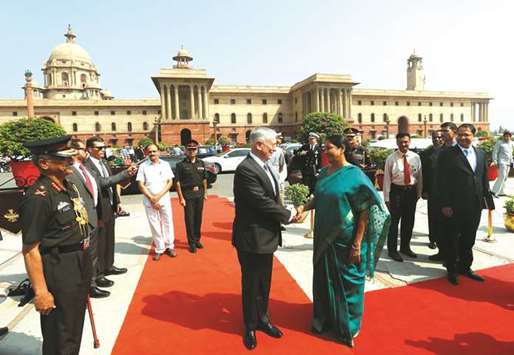India will not deploy troops to Afghanistan as part of a new US strategy for the war-torn country, Defence Minister Nirmala Sitharaman said yesterday, but she promised to boost support for the recently unveiled effort.
After talks with US Defence Secretary Jim Mattis, Sitharaman said India was prepared to increase training for Afghan personnel and help develop critical civilian infrastructure such as schools and hospitals.
“India’s contribution to Afghanistan has been for a very long time, and has been consistently on developmental issues,” Sitharaman said at a news conference with Mattis.
The “contribution has been on these grounds and we shall expand if necessary. However as we have made it very clear, there should not be boots from India on the ground.”
Mattis’ trip to India is the first by any member of President Donald Trump’s cabinet.
It comes just after Trump unveiled a new Afghanistan strategy and urged New Delhi to help.
“We applaud India’s invaluable contributions to Afghanistan and welcome further efforts to promote Afghanistan’s democracy, stability and security,” Mattis said.
India has long vied with Pakistan for influence in Afghanistan, building dams, roads and a new parliament in the troubled country.
Last year it offered some $1bn in aid.
It has also trained more than 4,000 Afghan National Army officers and provided helicopters to the Afghan Air Force.
Unveiling his Afghanistan policy last month, Trump angered Pakistan by saying it offered safe haven to “agents of chaos”.
“There can be no tolerance of terrorist safe havens,” Mattis said yesterday, without referencing Pakistan.
“As global leaders, India and the United States resolve to work together to eradicate this scourge.”
Defence ties between India and the United States have expanded rapidly, with New Delhi buying US weapons worth $15bn over the last decade, moving away from traditional supplier Russia.
Military experts say US weapons transfers aim at bolstering Indian capabilities to develop a counterweight against China’s growing assertiveness in recent years.
Indian and US negotiators are now trying to move forward with a deal to supply the Indian Navy with 22 Sea Guardian drone aircraft, whose June approval by the US
government was the first such clearance to a non-Nato ally.
India wants the unarmed drones to help its navy lengthen the duration of its surveillance in the Indian Ocean, where Chinese naval ships and submarines make regular forays.
Expanding naval co-operation with India was a top priority, Mattis said, adding that three-way exercises involving the United States, India and Japan boosted operational co-operation.
The Indian Air Force has also asked for 90 armed Avenger Predator drones that experts say could be deployed for cross-border strikes, such as targeting militant camps India says exist on Pakistan’s side of Kashmir.
Such a sale would need White House and Congress approval, sources said.
But Pakistan and, possibly, China could see the move as de-stabilising.
Dronemaker General Atomics is pleased the Indian government has won approval for the surveillance version of the drone, said Vivek Lall, its chief executive for US
and international strategic development.
“Not only will this platform enhance India’s capabilities in the areas of maritime domain awareness and security, but the interoperability with one of the US’s most important strategic partners will contribute to security across the region.”
The two sides will also discuss Lockheed Martin’s offer to build F-16 fighter planes in India as part of Prime Minister Narendra Modi’s drive to build a domestic military industrial base.
“We look forward to sharing some of our most advanced defence technologies,” Mattis said.
Sweden’s Saab is the other contender for the deal to supply at least 100 single-engine combat planes.

Defence Minister Nirmala Sitharaman shakes hands with US Defence Secretary Jim Mattis before their meeting in New Delhi yesterday.
